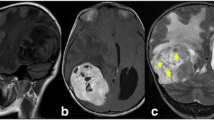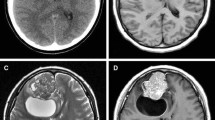Abstract
Objective
Astroblastoma is an unusual brain tumor in childhood. Tumor usually arises from cerebral hemispheres. This large tumor is well-demarcated, lobulated, solid or cystic, and therefore, may resemble glioblastoma. Histopathologically, there are two types of astroblastoma: well-differentiated (low-grade) or anaplastic (high-grade). In low-grade astroblastoma, treatment of choice is complete excision. This type of tumor usually does not recur. However, anaplastic tumors can recur despite surgery, radiation, and chemotherapy and may be problematic for clinician.
Case Report
A 7-year-old female patient presented with an acute onset of vomiting and seizure. Magnetic resonance imaging study revealed a large mass in the left parieto-occipital region. She underwent total excision of the tumor. Histopathologically, the tumor was an anaplastic astroblastoma. Her adjuvant treatment was planned to consist of radiation therapy and cisplatin-based chemotherapy. However, the tumor recurred early in the course, and she died 18 months after diagnosis.
Conclusion
High-grade astroblastomas behave like glioblastoma, as emphasized in this case report. Local control of this type of tumor seems difficult despite surgery, radiation therapy, and cisplatin-based chemotherapy.








Similar content being viewed by others
References
Bonnin JM, Rubinstein LJ (1989) Astroblastomas: a pathological study of 23 tumors, with a postoperative follow-up in 13 patients. Neurosurgery 25:6–13
Thiessen B, Finlay J, Kulkarni R, Rosenblum MK (1998) Astroblastoma: does histology predict biologic behavior? J Neurooncol 40:59–65
Bannykh SI, Fan X, Black KL (2007) Malignant astroblastoma with rhabdoid morphology. J Neurooncol 83:277–278
Navarro R, Reitman A, de Leon GA, Goldman S, Marymont M, Tomita T (2005) Astroblastoma in childhood: pathological and clinical analysis. Childs Nerv Syst 21:211–220
Pizer B, Moss T, Oakhill A, Webb D, Coakham HB (1995) Congenital astroblastoma: an unusual immunohistochemical study. J Neurosurg 83:550–555
Kaji M, Takeshima H, Nakazato Y, Kuratsu J (2006) Low-grade astroblastoma recurring with extensive invasion. Neurol Med Chir (Tokyo) 46:450–454
Caroli E, Salvati M, Esposito V, Orlando ER, Giangaspero F (2004) Cerebral astroblastoma. Acta Neurochir (Wien) 146:629–633
Kim DS, Park SY, Lee SP (2004) Astroblastoma: a case report. J Korean Med Sci 19:772–776
Denaro L, Gardiman M, Calderone M, Rossetto M, Ciccarino P, Giangaspero F, Perilongo G, d’Avello D (2008) Intraventricular astroblastoma. J Neurosurg Pediatr 1:152–155
Port JD, Brat DJ, Burger PC, Pomper MG (2002) Astroblastoma: radiologic-pathologic correlation and distinction from ependymoma. AJNR Am J Neuroradiol 23:243–247
Yunten N, Ersahin Y, Demirtas E, Yalman O, Sener RN (1996) Cerebral astroblastoma resembling an extra-axial neoplasm. J Neuroradiol 23:38–40
Cabrera-Zubizarreta A, Caton B, Martinez de Guerenu B, Larena-Iturbe JA, Ontanon JM, Catalan-Urribarrena G (2002) Low grade astroblastoma: pathological and magnetic resonance findings. Rev Neurol 34:936–939
Bell JW, Osborn AG, Salzman KL, Blaser SI, Jones BV, Chin SS (2007) Neuroradiologic characteristics of astroblastoma. Neuroradiology 49:203–209
Lau PPL, Thomas TMM, Lui PCW, Khin AT (2006) Low-grade astroblastoma with rapid recurrence: a cease report. Pathology 38:78–80
Mangano FT, Bradford AC, Mittler MA, Valderrama E, Schneider SJ (2007) Astroblastoma. Case report, review of the literature, and analysis of treatment strategies. J Neurosurg Sci 51:21–27
Husain AN, Leestma JE (1986) Cerebral astroblastoma: immunohistochemical and ultrastructural features. Case report. J Neurosurg 64:657–661
Notarianni C, Akin M, Fowler M, Nanda A (2008) Brainstem astroblastoma: a case report and review of the literature. Surg Neurol 69:201–205
Salvati M, D’elia A, Brogna C, Frati A, Antonelli M, Giangaspero F, Raco A, Santaro A, Delfini R (2009) Cerebral astroblastoma: analysis of six cases and critical review of treatment options. J Neurooncol (in press)
Miranda P, Lobato RD, Cabello A, Gomez PA (2006) Complete surgical resection of high-grade astroblastoma with long-term survival: case report and review of the literature. Neurocirugia 17:60–63
Pizer BL, Moss T, Oakhill A, Webb D, Coakham HB (1995) Congenital astroblastoma: an immunohistochemical study. Case report. J Neurosurg 83:550–555
Unal E, Koksal Y, Vajtai I, Toy H, Kocaogullar Y, Paksoy Y (2008) Astroblastoma in a child. Childs Nerv Syst 24:165–168
Author information
Authors and Affiliations
Corresponding author
Rights and permissions
About this article
Cite this article
Kantar, M., Ertan, Y., Turhan, T. et al. Anaplastic astroblastoma of childhood: aggressive behavior. Childs Nerv Syst 25, 1125–1129 (2009). https://doi.org/10.1007/s00381-009-0885-8
Received:
Published:
Issue Date:
DOI: https://doi.org/10.1007/s00381-009-0885-8




